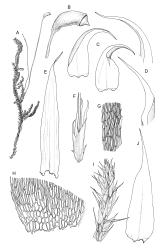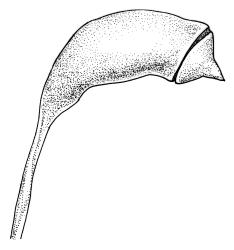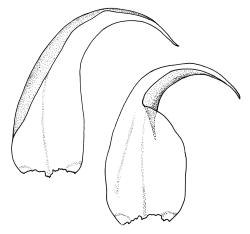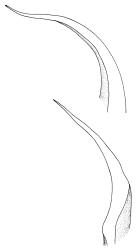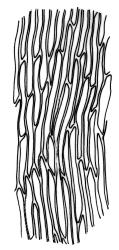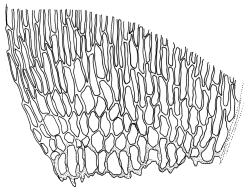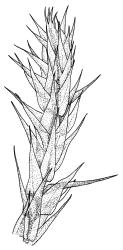- ≡ Hypnum brachiatum Mitt. in Hooker, Handb. New Zealand Fl. 472 (1867)
- ≡ Amblystegium brachiatum (Mitt.) Broth. in Müller & Brotherus, Abh. Naturwiss. Vereins Bremen 16: 509 (1900)
Drepanocladus polycarpos sensu Seppelt (2004).
Plants medium-sized, yellow-green, forming loose wefts. Stems mostly ascendant in self-supporting wefts, commonly 50–85 mm, subpinnately or irregularly branched, in cross-section with 4–5 layers of small and incrassate outer cells and an indistinct central strand; cortical cells mostly not stripping off with leaves. Stem leaves secund or ± erect-spreading, ± curved to falcate or nearly straight, closely spaced, mostly c. 2.0–4.3 × (0.8–)0.9–1.1 mm (under cover slip), ovate-lanceolate and gradually tapered to a rather short to elongate acumen, weakly narrowed to insertion, plane or broadly and loosely inrolled at margins, striolate when dry, entire, not decurrent; mid laminal cells smooth, vermicular, c. 65–110 × 4–6 µm, firm-walled, not or weakly porose (and then more distinctly porose near costa), tapered at ends, not differentiated at margins or at leaf apex; basal laminal cells usually wider (c. 9–12 µm wide), shorter, and more porose; alar cells moderately inflated, yellow-brown, forming a triangular group usually extending ½ or less the distance to the costal base, not or scarcely auriculate, grading ± gradually into the basal laminal cells. Costa mostly ill-defined, c. 45–60 µm wide near base, mostly c. ⅔ the leaf length and extending into the acumen. Branch leaves mostly smaller, often circinate at branch tips.
Autoicous. Perichaetia conspicuous on stems, with inner perichaetial leaves erect, c. 3–5 mm, narrowly lanceolate, plicate, costate, sheathing. Perigonia scattered on stems, often conspicuous below perichaetia, the bracts spreading. Setae long, slender, erect or weakly flexuouse, c. 35–45(–70) mm, red-brown, fading to straw-coloured in dried material, smooth; capsules short-cylindric and smooth, inclined to horizontal, strongly curved, c. 3.0–3.5 mm, with a short, abruptly tapered neck, constricted below the mouth but otherwise not altered when dry; mouth slightly oblique; exothecial cells ± oblong, firm-walled, not thickened at corners; stomata as per genus; annulus of 2–3 rows of non-inflated cells, apparently persistent at mouth; operculum conical. Exostome teeth yellow-brown, cross-striolate below, papillose above, bordered, strongly trabeculate but otherwise nearly smooth on inner surface; endostome as per genus, with the cilia paired and weakly nodose. Calyptra as per genus. Spores 15–21 µm, finely papillose.
Beever et al. 1992, fig. 75 (as D. aduncus); Seppelt 2004, fig. 49 (probably, as D. polycarpos).
Usually confused with D. aduncus in N.Z., but differentiated by its autoicous sexuality and consequent frequent production of capsules. The lack of adherent cortical cells (when stem leaves are stripped off) appears to be the most consistent non-reproductive difference from its congener. Less reliable but useful collaborative differentiating features are more strongly striolate dry vegetative leaves, more strongly concave and larger alar group, and the longer costae.
NI: N Auckland (probably), S Auckland (apparently frequent in general region of Ātiamuri/Rotorua), Gisborne (Tolaga Bay, Poverty Bay), Hawke’s Bay (near Wairoa), Wellington (Ōhakune, Miramar); SI: Nelson, Marlborough (Kenepuru Valley), Canterbury, Westland (probably), Otago, Southland; St; M (probably).
Australasian. Recorded from Australia by Hedenäs (1998).
In similar habitats to D. aduncus. In cation enriched or calcareous habitats, and often waterlogged and emergent. Verified occurrences are from near sea level to c. 1200 m (Mt Sebastopol, Canterbury L.D. and Mt Burns, Southland L.D.). A large fraction of the verified collections come from Canterbury and Otago Land Districts.
Hedenäs (1998, p. 99) designated a lectotype and interpreted its provenance as the "Maloma River". No river of this name exists in Otago L.D. or adjacent regions and Mitten’s transcription of the river name is illegible. It could possibly be a transcription error for Mavora and refer to either the short piece of the Māraroa River separating North and South Mavora Lakes or to another stretch of the Māraroa River. Paratype material from Tolaga Bay (Gisborne L.D.) is also present in NY-Mitten; it was apparently collected by J. Jolliffe, rather than Knight (as stated in the protologue). No type material of Hypnum brachiatum appears to be present in N.Z. herbaria. Hedenäs (1989, p. 90) indicated that D. brachiatus is the only autoicous taxon in "the Drepanocladus sendtneri complex."
The taxonomic and nomenclatural confusion surrounding this species is related to the difficulty in defining clear species limits in Drepanocladus, due to pronounced morphological plasticity. Dixon (1929) proposed that Amblystegium longifolius Mitt. [=D. longifolius (Mitt.) Paris], with a type from the Falkland Is., was conspecific with D. brachiatus. Dixon’s discussion of D. brachiatus is confusing because of his statement that it is "dioicous and very rarely in fruit." Dixon’s observations do not agree with my observations on the type and are therefore not considered further here.
Hedenäs (1998) provided a detailed description of D. brachiatus in his discussion of the "Drepanocladus sendtneri complex"; he referred to D. brachiatus as "an evolutionary entity separate from the rest of the D. sendtneri complex" (a widely-distributed cluster of taxa intimately related to D. aduncus). Żarnowiec’s (2001) treatment (of the "D. aduncus group") was extremely detailed, and included seven full-page illustrations of D. polycarpos based on his concept of this species and a very detailed description based on the syntypes of Hypnum brachiatum Mitt. Hedenäs (2003) recognised Drepanocladus longifolius (Mitt.) Broth. in his treatment of South American species, without mentioning D. brachiatus. Seppelt (2004) was influenced by Żarnowiec in his decision to recognise D. polycarpus from Macquarie I.
While experience of the genus on a wider geographic scale might clarify relationships between D. brachiatus and D. aduncus, I do not believe that further study of morphological variability in N.Z. will lead to a clearer understanding of their relationships.




